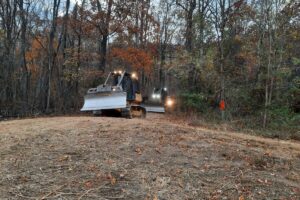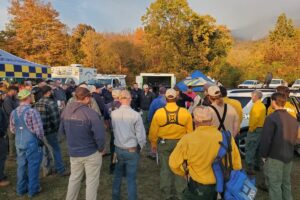The Quaker Run Fire from a Wildland Firefighter’s POV
January 5, 2024 10:54 am

By Joe Rossetti, DOF Hardwood Initiative Coordinator –
The Quaker Run Fire in Madison County garnered a great deal of attention, and rightly so. A fire this large, at nearly 4,000 acres, rarely occurs in Virginia. Suppressing this fire proved particularly challenging because, on top of the usual fall fire seasonal weather conditions like low humidity and gusty winds, the region was experiencing a persistent drought. It also occurred on steep, remote terrain that was challenging for our wildland firefighters to access. In this blog, I’ll share my point-of-view (POV) experiences as a wildland firefighter working on the firelines at the Quaker Run Fire.
Most wildland fire suppression work occurs during the day because it’s safer for firefighters to operate when they can see, especially when the fire is on steep, rocky terrain. Fighting fires during the day also helps firefighters remain well-rested by following regular sleep cycles. This doesn’t mean everyone goes home when the sun sets. Firefighting will extend through the night for fires such as the Quaker Run Fire when they are of a certain size, threatening homes or could escape containment. I was on the night shift at the Quaker Run Fire, and in this blog, I’ll share my POV on the fire lines at night.
During the day, as many as 200 people worked on the fire, supported by bulldozers, helicopters, engines and UTVs. The night crew was much smaller and only utilized a few engines and UTVs. With less workforce and resources, our role was to monitor the fire overnight and execute other tasks as needed.
- Bulldozers leaving Doubletop Mountain.
- A bulldozer installing a fireline on Doubletop Mountain.
One of the first things needed on a large fire is a map. A map conveys key information including the location of structures in need of protection; trails, roads, and access points; topography; and natural firebreaks like rivers. A good map allows firefighters to plan where to deploy resources, predict fire behavior and determine where firelines should be installed. Firelines are paths where all flammable materials—such as leaves—are removed. This cuts the fire off from its fuel source, which, in most cases, stops its progress. Good maps were crucial with the challenging terrain of the Quaker Run Fire because some areas were too steep and rocky for effective firelines.
On my first night at the Quaker Run Fire, it was clear we couldn’t work directly on the fire edge, so scouting for key locations and landmarks was the best thing we could do to help the firefighting effort. That night, we mapped and labeled numerous trails and structures near the fire and printed the first map for crews to use during the day. Mapping efforts by the night shift continued through the duration of the fire, adding other trails, woods roads, and structures. We also provided accurate mapping of firelines as they were constructed during the day.
Several days into the fire, the first Incident Action Plan (IAP) was produced. An IAP is a written document used on wildfires and other long-duration emergency response incidents (hurricanes, tornados, floods) that helps responders organize and share information about the incident, the people who are working on the incident, and how they can communicate with each other. Supplies to print the IAP hadn’t arrived yet, so the night shift printed and prepared the IAP at the local DOF office, in addition to updating the map and monitoring fire spread. It was ready to go when the day shift arrived at the fire.
- Wildland firefighters and support staff from local, state and federal departments gather for morning briefing.
- Safety Officer Dave Powell from DOF reminds firefighters how to remain safe while on the firelines.
As the fire grew, so did the number of personnel and equipment on the scene. The Incident Command Post (ICP) is the hub of activity for personnel and equipment. It’s where the people in charge are generally found, where equipment is kept, where supplies are brought for firefighters, and where the food and drinking water are provided. As the number of people and resources increased, the ICP was rearranged to accommodate the growth efficiently. But that’s hard to do during the day with lots of people and activity; so it’s done during the night shift! While we were at it, we went ahead and washed the windows on the bulldozers and UTVs. Who doesn’t like to see better for a little while?
One of our most important tasks during the night shift was to patrol the firelines overnight and prevent the fire from escaping containment. Wildfires are typically most active during the afternoon and early evening. As it gets later, relative humidity rises, winds subside and temperatures drop, reducing fire activity. While many firefighters may patrol the lines during the day when the fire is very active, just two or three firefighters can often patrol the same lines at night when the fire burns slower and the flames are smaller.
- Wildland firefighters conduct burnout operations.
- A wildland firefighter watches the flames from a fireline.
During fireline night patrols, I concentrated on the areas where we thought the fire was most likely to escape containment and threaten structures. Every night on the fireline was different. One night was so cold and humid, we got snow flurries! There wasn’t much fire activity that night. Most nights the fire burned well through the night with two-to-three-foot flames. When the fire was that active at night, I was glad I wasn’t seeing it during the day!

POV of burnout operation monitoring.
The fire approached firelines several times during my night shifts. On a few occasions, the night shift came across a spot where the fire had managed to jump over the fireline. Wildland firefighters call this a “spot over.” One of these spot overs became too large for the night shift to contain. Luckily, it wasn’t threatening any structures, so we again mapped existing trails and informed the day shift of the location of the spot over and the trails they could use to contain it.
On another occasion, a spot over occurred that was capable of threatening structures before the day crew arrived, so our night crew installed a fireline to contain it. I’m glad to say that fireline held. The following night, a third spot over occurred in a more challenging location that we were unable to contain, but we were successful at slowing the spot over enough to give the day shift time to install firelines before the fire was able to reach any structures.

A wildland firefighter fells a burned snag.
As the firelines became more well-established and the fire was increasingly contained, the night shift focused on eliminating dangers inside the containment area. Standing dead trees (or snags) are a significant threat on firelines. Snags can burn to their top and cast embers across the fireline, compromising containment. They can also burn through at the base and fall across the fireline, again compromising containment and posing a direct hazard to firefighters. To prevent these hazards, snags are cut down or “prepped” by removing all of the fuels around them to prevent them from igniting. For safety reasons, we don’t cut trees down at night, so the last several nights I worked, I raked around a lot of snags to remove fuels and prevent them from burning.

Wildland firefighters conduct mop-up.
Shortly after I stopped working on the fire, the fire was pretty well contained and crews entered the mop-up phase. During mop-up, firefighters enter the containment area where the fire has cooled and eliminate any remaining hot spots. There is no need for the night shift during mop-up, as there is little threat of the fire escaping.
Firefighting is a team effort. Like all teams, each firefighter has to put forth their best individual effort to do their job wherever they are on the fire, whenever they are there. Each person’s role is different, whether it be installing firelines, directing resources and planning, or coordinating supplies for everyone else. Operations run smoothly when everyone does their job to the best of their ability and then does something more to make the next person’s job easier. That was our approach to the night shift: Do what was asked of us, then do a little more to make the day shift’s jobs easier and more productive.
See more pictures of the Quaker Run Fire on DOF’s Flickr: https://www.flickr.com/photos/vdof_photos/albums/72177720312817872/
Tags: Wildfire Suppression
Category: Fire and Emergency Response






